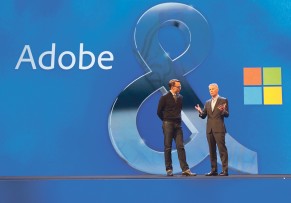Big data has disrupted the traditional marketing function, giving marketers access to swathes of information at the touch of a fingertip. When data is successfully analysed and measured, marketers can gain insight on customer trends and behaviour to deliver more personalised experiences. This knowledge also allows them to be taken more seriously at board level and credibly steer business decisions.
Yet growing mountains of data from customer interactions across multiple touch-points can be overwhelming. We are no longer talking about gigabytes of data, but petabytes, exabytes and zettabytes.
So how can marketers sift through the data and turn it into actionable customer intelligence? Enterprises are facing two major challenges. The first is gathering the structured information you have on your customers from different areas of the organisation, and making sure marketing, sales and services interactions are not delivering siloed, disconnected experiences. The second is managing the massive amount of unstructured content, such as social activity and engagement with third parties, and using it to its full potential.
 Bringing together this structured and unstructured data will create a complete, contextual view of the customer, allowing businesses to analyse valuable customer insight regardless of its source and format. Yet this data is only useful to marketers if they are able to act on it in real time, and respond to changing customer needs and preferences to deliver a personalised experience.
Bringing together this structured and unstructured data will create a complete, contextual view of the customer, allowing businesses to analyse valuable customer insight regardless of its source and format. Yet this data is only useful to marketers if they are able to act on it in real time, and respond to changing customer needs and preferences to deliver a personalised experience.
At Adobe, we recently partnered with Microsoft to make this easier for enterprises, enabling businesses to transform fragmented interactions into a single, unified customer experience. The partnership offers customers the ability to align sales and marketing activities by tightly integrating audiences and their behaviours, as well as combining web-behaviour data with other aspects such as order history and loyalty status to identify where a customer is in the sales cycle. This means the right content can be delivered at the right time, whether on a landing page, an e-mail or as an alert through a mobile app.
Consumers tell us time and time again they are happy to share their data if it results in more consistent personal digital experiences. For example, offers for restaurants near their home or films based on what they’ve watched before. This is backed up by research carried out by Adobe which found that the vast majority of people in Europe (88 per cent) want, or are open to, recommendations and personalised experiences delivered to them in this way.
Personalisation can set brands apart and is proven to boost sales, but data on its own will not deliver the perfect brand experience. Indeed, analytics will help to identify targets and understand customers, but it only allows us to see clearly a small portion of how consumers are really responding. Often there is a lot more bubbling under the surface which needs to be fully understood.
Modern marketers able to complement their ability to interpret data with emotional intelligence will be the ones to get the most from analytics
In the present day and age, there is an argument that many marketers are becoming far too data devoted and are not looking beyond the numbers in front of them. A growing number in the profession do not just allow data to inform their decisions, they allow data to make every decision for them. Yet when it comes to personalisation, in particular, poor judgment and ignoring the usual rules for human engagement could mean they risk coming across as “creepy”.
There is a fine line between using big data to deliver targeted marketing messages and invading consumers’ privacy. Over-familiarity can be a real turn off for online consumers. As in the real world, one person’s friendly nature could be perceived as over the top by another. Similar to when you have an over-enthusiastic shop assistant following you around in-store, an intrusive brand online could lose your custom.
When using big data for personalisation, brands need to ensure they do not misuse the information at their fingertips and leave consumers feeling stalked or that their personal space has been invaded. After all, this runs the risk of negatively impacting the purchasing decision, which goes against the original objective – creating a loyal customer base.
[embed_related]
Modern marketers able to complement their ability to interpret data with emotional intelligence will avoid this indiscretion and will be the ones to get the most from analytics. To answer the questions big data doesn’t, marketers need to be analytical and data driven, but also have a good understanding of the brand, storytelling, experiential marketing and the level of familiarity consumers will be receptive to.
The ability to wear two hats is particularly important at a time when marketers are moving beyond existing digital channels to include physical experiences in the real world. It’s an exciting time in the profession with the arrival of personalised experiences in shops, hotel rooms and wearable devices.
The potential to trial new ways of engaging with customers is endless, but until there is a history of data to show how consumers typically behave in these new scenarios, what they will be receptive to and what they will find too much, marketers will need to revert back to trusting their instinct. While technology is available to begin the process of measuring, analysing and improving user-engagement in real time, marketers should be thriving on the opportunity to use their own judgment to get the balance right across these new touch-points.
In the information age, brands are using highly targeted, highly relevant content to stand apart from the competition. If marketers can manage the juggling act of handling big data to get a single view of the customer, acting on insights in real time and looking beyond the numbers to the bigger picture for how a customer wants to engage with a brand, they will become hugely valuable to the business.
CASE STUDY: ASOS
As an e-commerce company, ASOS does not have the benefits of person-to-person interaction in a retail setting or face-to-face interaction with its customers.
However, with eight million active customers and tens of millions of monthly visits to its website and via its mobile apps, ASOS has the ability to sift through large volumes of data to look for clues they can use to improve business.
Traditionally, their analysts pulled data from an analytics tool and pieced it together in a way that could be shared with business stakeholders. But the tool wasn’t dynamic or reactive enough to support ASOS’s needs. What’s more, the large number of site visits and the variety of channels and devices that customers use to interact with the site made it a huge challenge to draw actionable customer insights.
With increased automation, as well as the ability of Adobe Analytics to run attribution and prediction reports, ASOS marketers now spend less time reacting and more time predicting and planning for the future as well as proactively solving problems.
Adobe Analytics shows cross-channel views of customer interactions and supports real-time actionability to influence outcomes. Using this tool, businesses can monitor campaigns and promotions, optimise content and connect digital channels to the business.
ASOS now uses Adobe Analytics to not only gain insights after an interaction has occurred, but also to take action while a customer is still engaging with the site. The business now relies on analytics maturity – the ability to collect real-time data – to help it redefine the way it approaches marketing.
For ASOS, focusing on analytics maturity has helped it better understand its customer and enable its analysts to maximise their skill-set by freeing up time that can then be spent on other projects. As a result of enhancing its analytics capabilities, ASOS now better understands its customers, which in turn helps to improve key indicators, such as conversion rates and revenue.
David Williams, ASOS head of customer intelligence, concludes: “The main reason for choosing Adobe was that we were very, very impressed with the Adobe Analytics capability to do segmentation, to do near-real-time reporting, and to change the dimensions and measures that you’re looking at as you’re actually building the reports.”
Digital marketers are using Adobe Marketing Cloud to stay ahead. Find the latest insights, advice and discussions at blogs.adobe.com/digitaleurope
Adobe Marketing Cloud is also on Twitter @adobemktgcloud
For more information on Adobe Marketing Cloud, please visit adobe.com/uk/marketing
To find full details of the research which found that the vast majority of people in Europe want customisation of products, please visit www.adobe.com/aboutadobe/pressroom/pdfs/Click_Here_Regional_Comparisons.pdf

CASE STUDY: ASOS



